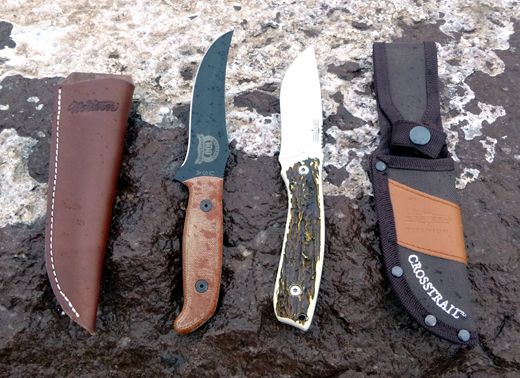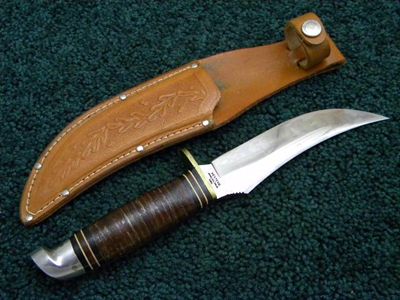
| Articles | Documents | Equipment | Events | Links | Membership | Miscellaneous | Scrapbook | Targets | What's New |
|
Bladeology Today's Western Knives |
February 2017 | |||
| Dan Martinez | ||||
Today the famous Western knife company of the mid-20th century is no more.
In 1984, Western Cutlery became part of the respected Coleman outdoor products
company. Under Coleman, most of the classic Western knife patterns continued
to be produced, and some new knives were introduced.
In 1991, Camillus, one of the oldest knife makers in the U.S. purchased Western
Cutlery from Coleman. Many of the Western knives from the Coleman era continued
to be produced, but cost cutting measures became evident.
In early 2007, Camillus declared bankruptcy due to overseas competition and from
poor management. Camillus’ bankruptcy was the end for the classic patterns of
Western hunting and outdoor knives.
In late 2007, the Acme United Corporation purchased the trademarks and brands of
Camillus, including Western. In 2009, Acme United re-launched Western knives as
a sub-brand under Camillus. Today Western knives are a sister brand to the Les
Stroud brand of survival knives and other Camillus brands. The new Western knives
have no real relation to the classic Western Cutlery knives.
Product lines are always changing, but as I write these words, Camillus lists 14
knives branded as Western knives. I have picked up a few examples of these knives
due to my interest in the historical Western knives. As usual, this is not a
comprehensive look at these modern Western knives, as I only acquired the ones
that caught my eye.
Fixed Blades
The L39 pattern is characterized by an upswept blade with quite a sharp piercing point.
The deep curve of the belly of the knife made it a perfect skinner and it was one of
the most popular patterns in the classic Western knife lineup. Western Cutlery also
made a slightly smaller version of this basic shape, the stacked-leather-handled L40
and the model 640 which had a Delrin imitation jigged bone handle. Our buddy Wade
owns a model 640.
Introduced in 2011 to commemorate the 100th anniversary of the founding of Western
Cutlery, another feature of the Western Skinner that harkens back to the originals is
the pronounced thumb ramp with traction grooves, known in the knife world as “jimping”.
This aids fine control of the knife in use.
Instead of Western’s classic split-tang construction, the 100th Anniversary Skinner
employs full tang construction and brown Micarta handle scales. The pommel mimics
the profile of the classic aluminum saddle horn pommel. The blade is made of .145”
thick 1095 high carbon steel. To prevent rust, the blade is coated with some type
of a black finish. Of the modern Acme United Westerns, this is the only one made in
the U.S.A.
The knife comes with a high quality pouch style leather sheath that swallows up about
one-third of the length of the handle. Western’s classic rope-script logo is embossed
into the leather near the top. This is a beautiful, top quality knife that comes from
the factory extremely sharp and it is one that I am proud to own.
I picked up one other modern Western fixed blade knife, the 9” Crosstrail. This
is a thoroughly modern knife that owes nothing to the Western knives of old. It is
made of “Titanium Bonded” 420 stainless steel. This is what Acme United/Camillus says
about that:
“Titanium Bonded is not painted or plated, but an application of a unique formulation
of titanium and chromium nitride to the surface of cutting blades that actually
penetrates and treats the metal to create a permanent bond. The patented Titanium
Bonding process provides the following benefits; corrosion resistance, adhesive
resistance and the process itself makes the stainless steel 3x harder than untreated
stainless providing a blade that stays sharper longer.”
I don’t know how much of that is truth versus marketing hype, but there it is. It is
apparently not a very expensive process, as the Crosstrail can be found most places
at a price under $20.
The blade profile is a broad drop point design with a full belly and is hollow ground.
It may be a better skinner than even the 100th Anniversary Skinner because as a drop
point, it lacks the sharp piercing point that is the hallmark of the L39 profile. It
is less likely to inadvertently poke through the hide during a skinning operation.
This knife is also full tang in construction and features faux stag Delrin handle
slabs. What is interesting about the slabs is that they vary noticeably in thickness
to mimic natural handle materials.
There is another version of this knife that features a gut hook on the back of the
blade. Then there are two other versions that use the same blade blanks, guthook and
non-guthook, but with black rubber grips. These knives use the name Black River
instead of Crosstrail. I was drawn to the stag handled Crosstrail as it seems more
classic.
The Crosstrail comes with an attractive, but inexpensive woven nylon sheath, backed
with stiff plastic to give it shape. The sheath features a slash of thin leather
wrapped around the middle embossed with a new Western logo and the word “TITANIUM”.
It seems like a fine sheath until you realize that the snapped keeper strap that
goes around the handle does not do the job of keeping the knife in the sheath. The
knife can be pulled straight up through the snapped strap without much resistance at
all. That is mainly due to the fact that the knife lacks any kind of a finger guard
in its design that would catch on the strap if it was there.
The back of the knife above the handle features jimping, but no thumb ramp. The
blade thickness is the same as the 100th Anniversary Skinner at .145”. Overall, it
is a very nice knife, quite sharp out of the box. If you’re looking for a decent
fixed blade outdoorsman’s knife at a good price, the Western Crosstrail deserves a
look.
Folders
These are definitely modern EDC knives. Nudge the blade open using the ambidextrous
thumb stud, then a quick flick of the wrist throws the blade open where it locks by
the engagement of a liner lock. Each knife also features a pocket clip as most
modern folders do these days.
If it seems silly to offer two pocket knives so close in size to each other, you
will find that it definitely makes sense when you have them both in your hands.
Besides being shorter, the 7” Pronto is also skinnier, less bulky overall. It is
the better knife to have on you in the course of a typical day. The 8” Pronto is
more the size and bulk of a Buck 110, but a bit less heavy. Either could be used
as a hunting knife, but the bigger one is probably the one you would choose for
such a task.
Like the Crosstrail, both of these have sister knives with black rubber grips
instead of Delrin stag. These rubber gripped folders go by the name of BlacTrax.
The final Acme United Western knife I have is the Granpa Trapper. I
mentioned that the product line is under constant change. This knife appears to
be already discontinued, but old stock is still available online from a number
of suppliers. It is a classic two-bladed Trapper with blades about 3¼” long with
Delrin stag scales.
Because they are imported, each of the four Delrin stag handled Westerns I have
discussed are around $20 bucks or less, yet are very nice in quality. Check
them out.
© Honeywell Sportsman Club. All rights reserved. | ||||
|
The Honeywell Sportsman Club is a small group of shooting and outdoor enthusiasts in the Phoenix, Arizona area. Our website is ad-free and completely free to use for everyone. But we do have expenses that we need to cover, such as the web hosting fee and our liability insurance. If you enjoyed visiting our website, found it useful in some way, or if you enjoyed reading this story, please consider tipping us through our PayPal donation jar below. Thanks for visiting, and come back soon. |

|
|




